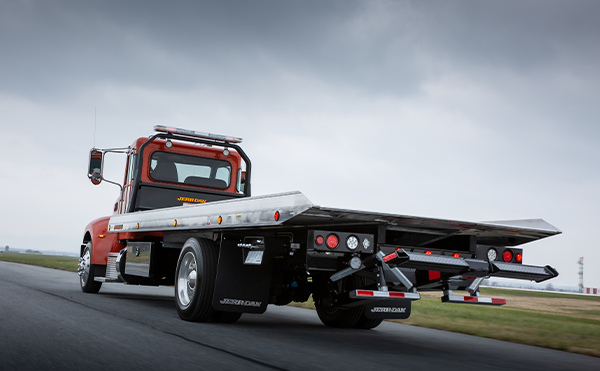
Brian J Riker
President and Chief Compliance Specialist,
Fleet Compliance Solutions, LLC
A version of this column originally appeared
in the April 2022 Issue of American Towman
Our industry does a great job of making available and promoting training in recoveries, winching, and other complex operations that are all part of a tow professional’s job. Where we fail miserably as an industry is training our drivers how to drive better. Instead, we expect them to just naturally know how to operate multiple types of motor vehicles safely and effectively without any formal training.
Think about how much time you, or your drivers, spend behind the wheel of your truck compared to the time spent loading, winching, or otherwise handling a vehicle with the tow truck or carrier bed. For most towers, I estimate that it is at least a 70/30 split, if not greater. Also ask yourself, when was the last time you spent any real effort on coaching or training your team to drive better? How many of your insurance claims were for damage to towed vehicles versus accidents or other incidents involving actually driving or maneuvering a truck?

Options for coaching or training drivers
There are many affordable and effective options available for training or coaching your drivers to develop or reinforce better driving habits. Many of these options don’t even require your driver to be in an actual tow truck, they can be classroom activities or even demonstrated in a passenger vehicle. Often the key to success is just shifting their mental process so they think about the risks more clearly.
Safe driving begins with the hiring process and daily operations of the company. You can’t expect your drivers to be expert motor vehicle operators from day one nor can you reasonably expect them to always practice safe habits when they are being pressured to expedite every call. I understand the driver pool is shrinking and as a tow boss you may be tempted to hire the first warm body that walks thru your door and meets your insurance company’s minimum qualification standards.
A thorough review of the applicant’s driving record, including the Federal Motor Carrier Safety Administration’s Pre-employment Screening Program, may show a pattern of dangerous driving behaviors or other issues that could indicate a lack of adequate skills. Now, just because an applicant has a few dings on their record doesn’t mean they shouldn’t be hired, but those dings need to be explained and you need to take action to monitor for bad behaviors while they are working for you.
Drivers, this means what you do off-duty in your own car or on your motorcycle has a direct impact on your ability to get hired or keep a job! Insurance companies look at risky behavior, even when it doesn’t happen in a truck, and presume you will take risks while operating a truck. Statistically speaking they are correct. There is a direct relationship between unsafe operation of cars and poor performance as a truck driver. With commercial auto insurance getting harder to obtain each year and the provider market shrinking, insurance companies are dictating who can be hired or keep their job more than ever before. You may be the best at recovery and towing but if your license isn’t mostly clean you may find yourself out of a job.
What about once you have hired a driver, what should you do to keep them safe and insurable? Regular review of their driving record, reviewing any complaints, and even comparing their vehicle maintenance history can help identify risky behaviors. A driver with a habit of tailgating will wear out their brakes sooner than a driver that maintains adequate following distance and slowly comes to a stop.
GPS monitoring and cameras are very popular right now and for good reasons. Besides providing a clear picture of what happened when there is an event, and usually providing an excellent defense for your driver (we all know the majority of truck-involved crashes are the fault of the other vehicle) the data from telematic devices provide perfect opportunities to coach a driver. I do not support using telematics as a management tool with the intent of catching someone doing something wrong and punishing them for it—that is a bad way to use the data. Rather I strongly encourage fleet managers to use the data to coach or guide their drivers to help them succeed.
We all make mistakes occasionally, often without even realizing what we are doing or how it may be dangerous. I have dash cameras in all my personal vehicles and even travel with a portable camera for rental cars. I review my video files often to monitor and self-coach my performance.
I compare it to an athlete reviewing game day tape to look for ways to improve. Try it! I can pretty much guarantee you will be shocked at some of the things you do daily without even realizing it.
Defensive driving tipsWhen coaching drivers, regardless of how the data is collected or if there is no data, the following tips will provide a safer experience for all motorists. Remember, in today’s world, most roadway users are distracted by electronics or otherwise not paying attention. Therefore, as a professional driver, it is your duty to drive not only your own truck but their car as well. I wish it wasn’t this way, but it is, and I don’t see it changing any time soon.
Maintain Situational Awareness – You can’t react to an event if you are not aware it is happening. The only way to know what is happening around you is to always be aware, constantly scanning in front, behind, and alongside your vehicle. A good driver completes this sweep every 5-7 seconds checking traffic in front of them for hazards, alongside for obstructions to a good escape route, and behind for potential trouble. It is paramount that you are constantly aware of your surroundings— stale green lights, vehicles waiting to pull out or turn, pedestrians waiting to cross or people walking without paying attention.
Increase Eye Lead Time and Following Distance – The average driver only looks about 4 seconds in front of their vehicle and follows even closer, at about 2 seconds. This simply is not enough time to react to a hazard once it is perceived. The average human takes at least 0.75 of a second to perceive (recognize) a hazard and another 0.75 of a second to begin to react to the hazard. At 60 MPH (88 feet per second) you have traveled 132 feet before even beginning to slow down, so I hope your brakes are in excellent condition. Oh, and if you have an air brake equipped vehicle that adds another 0.75 of a second to the equation for brake lag time, meaning at 2 seconds of the following distance you have already hit the hazard in front of you before your breaks even begin to apply.
Most experts recommend at least 4 seconds of following distance for a normal passenger vehicle and to increase that distance by 1 second for each 10 foot of vehicle length when driving a commercial vehicle. I simplify that recommendation by calling for 7 seconds of following distance whenever operating a commercial vehicle, loaded or empty, and increasing that by at least 1 second when on wet or slippery roads. I know this seems like a lot and in heavy traffic other motorists will fill the gap, but it is important to give yourself enough room/time to slow and stop your vehicle. Large commercial vehicles take extra time to stop. We can’t change the laws of physics.
As for “eye lead time”, that is the distance you are looking ahead when you scan traffic in front and to the sides of you. Most experts recommend at least 7 seconds. However, I personally recommend as far as possible with a minimum of 15 seconds. This will give you almost 0.25 mile (at 60 MPH) to perceive and react to any roadway hazard. Eye lead time is critical to situational awareness.
Plan Your Escape – Always be planning where you will go in case of an emergency. This is a continual exercise as you drive. Think about what would happen if you needed to instantly change lanes, drive to the shoulder, or wherever else may be available. Often your only escape will be slowing down and stopping so make sure you have adequate stopping distance. Planning for an escape route also requires avoiding driving in packs, meaning slowing down and letting the group of vehicles get ahead of you. The safest place to be is in open air away from other vehicles. Avoid riding directly alongside other vehicles whenever possible and always maintain awareness of where the vehicle that just passed you currently is to avoid striking it if you need to suddenly make a lane change.
Be Well Rested and Avoid Distractions – Often we allow ourselves to skip rest and try to push through fatigue, especially in this business. This is very dangerous. Studies show that fatigued or distracted drivers are just as impaired as drivers that have consumed 1.5-2 alcoholic drinks. Get adequate rest before driving and note that simply complying with DOT hours of service regulations does not mean you are well rested. Each person is different, but the average adult requires at least 6 hours of sleep daily to be rested.
Distractions come in many forms besides cell phones. As towers that often must dodge distracted drivers that enter our workspace, we are well aware there is a huge distracted-driving problem.
But are you aware that it is much more than cell phone use? How often have you driven for several miles and then realized you don’t remember any of the last few miles? This is likely because your mind was wandering and you really were not paying attention to the task at hand— driving. What about when you are distracted by personal or work problems? Maybe you are still upset about an argument with your spouse or a rude customer. These types of distractions can be just as deadly as cell phone use, so please make sure your mind is clear before driving.
Summary
I would like to end by saying that driving is not secondary to your job as a towing and recovery operator or road service technician. Actually, I believe that it is the most important part of the job. Yes, you need very complex and highly developed technical skills to do the job of a tow operator but if you can’t get to and from the disabled vehicle safely are you truly good at your job?
We are only human. None of us are perfect but please think about how you can improve as a driver. We must lead by example on the roadways if we expect to see any improvement in roadside safety.